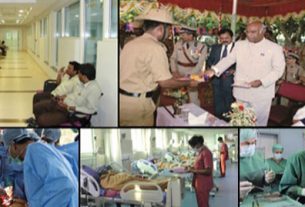In the third wave of the pandemic, general practitioners played an important role in the treatment of Covid patients due to extensive immunization and a milder version of the virus.
In January, a 37-old general practitioner, sat at her desk, with a stethoscope around his neck. About 90 people arrived in one day in January, the majority of whom had flu-like symptoms. The bespectacled doctor, on the other hand, realized that for many people, this was Covid-19, not the flu.
“These patients have known me for years, I can not ignore their health,” said Saraogi, who suffers from diabetes and has undergone surgery. Her relatives chastised her for prioritizing the health of her patients over her own. Saraogi saw 70-80 patients per day on average.
If the first wave of Covid-19 was marked by a nationwide lockdown, the second wave was distinguished by victims’ relatives scrambling for hospital beds and oxygen. The third wave has been highlighted by congested waiting rooms of general physicians across the country.
The majority of patients who sought medical advice did so because they were experiencing symptoms but their test came back as negative. That these people knew they’d been exposed to someone who tested positive for Covid-19.
Compared to the first wave of Covid in May 2020, the third wave in February 2022 saw fewer quarantine mandates. Sidharth Rao, a 33-year-old IT professional, was advised to stay at home and follow precautions.
Due to milder symptoms, people suggested taking up consultation from a family doctor first. A short film-maker from Bengaluru said that only if the situation gets severe, one must go to the hospitals. “I was worried because I did not see many people going to family doctors in the first and second wave of Covid-19,” he said.
The majority of patients under home quarantine consulted their family doctors. According to two family doctors, the number of patients seeking advice jumped by at least 50 per cent in January.
“Every time we take a chance like this, we’re taking a risk. I didn’t consult over the phone because I believe it’s crucial to see the patient in person,” said a general physician.
According to data from the Indian Medical Association (IMA), India lost 747 doctors to Covid-19 in the first wave and 776 in the second wave.
There was a big surge in the purchase of self-testing kits. People started testing the virus at home. Due to which the government had no data of Covid-19 positive patients.
Balram Bhargava, director general of the Indian Council of Medical Research (ICMR), said on January 20 that 2,00,000 home testing kits had been utilised in the first 20 days of January 2022, compared to 3,000 in the entire year of 2021.
Self-testing kits were more popular in Bengaluru, but the majority of those who bought them failed to scan the QR code on it. They didn’t even send the result reports to the city government. As a result, the civic authority has made it essential to provide Aadhaar Card number when purchasing self-testing kits, said S.M Prasad, president of the IMA’s Karnataka unit.
Doctors were additionally overworked as a result of increase in Covid-19 cases, as India has far too few doctors for its population. India has one doctor for every 1,308 people, compared to the World Health Organization’s (WHO) target ratio of one doctor for every 1,000 people.
Vaccinations also help to keep situations mild, according to Prasad, “Waves like these will continue to arrive, but we’ll become accustomed to them.”



